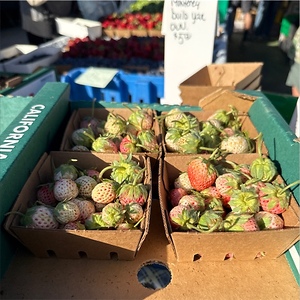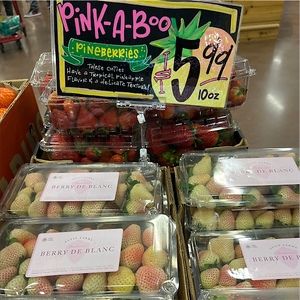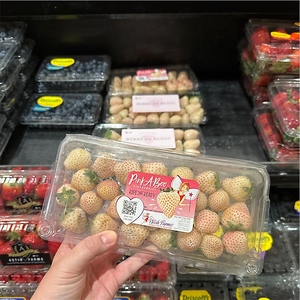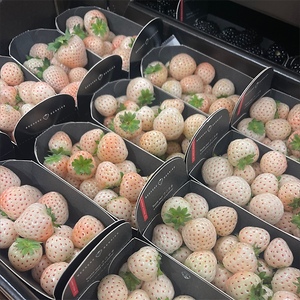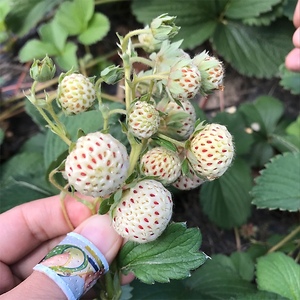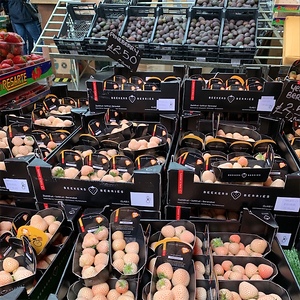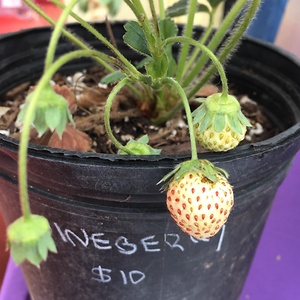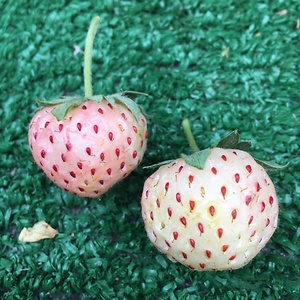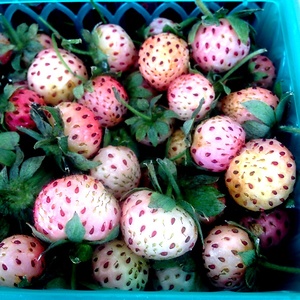

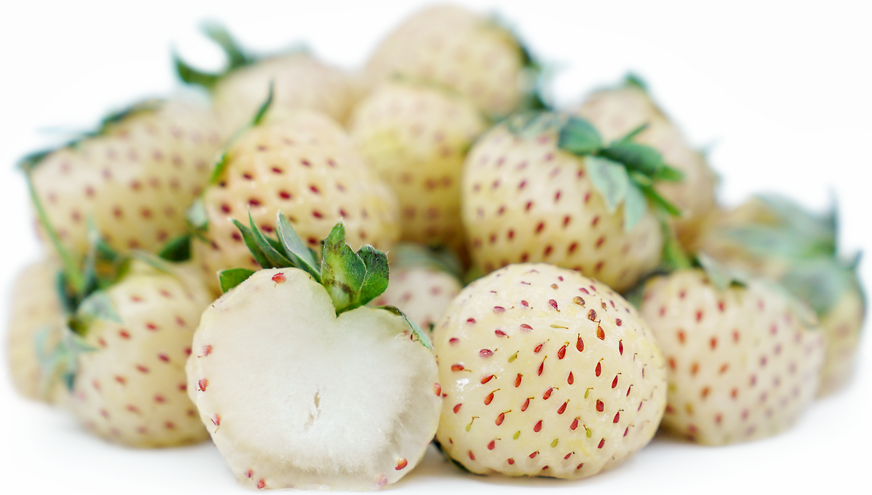
Pineberries
Estimated Inventory, 12 ct : 0
This item was last sold on : 06/14/24
Description/Taste
Pineberries are small conical berries that measure between 15 and 23 mm long, slightly larger than a dime. They are distinguished by their white, nearly translucent skin with patches of blush pink hues. Pineberries are covered in bright red seeds and when cut in half, reveal a creamy white flesh. They have a firm yet juicy texture and an aroma that smells of pineapple, pear, and apricots. Pineberries have strong flavors of strawberry and pineapple, with subtle undertones of dragonfruit.
Seasons/Availability
Pineberries are available from late spring to early summer.
Current Facts
Pineberries are botanically classified Fragaria x ananassa ‘Pineberry’. They are also referred to as Hula berries and by their German name, Ananaserdbeere, which translates to pineapple strawberry. Pineberries are sold under many different brand names including Pink-a-Boo®, Florida Pearl®, and simply, the Pearl®. As a hybrid, they are nutritionally and genetically similar to strawberries, one of its parent fruits. The two require similar care and growing conditions and are harvested in the same seasons. One of their differences is their seed colors: strawberries' are yellow and Pineberries' are red. Pineberries are also smaller than strawberries, have a more tropical scent, and have completely white flesh. Pineberries have a white and light pink hue because they lack the flavonoid anthocyanin, which gives strawberries their red color.
Nutritional Value
Pineberries are a good source of Vitamin C, which helps with immune function, skin health, and tissue repair. This vitamin can also improve iron absorption from plant-based foods. Pineberries contain folate and fiber, which are important for cellular health and growth, fetal development, digestion, lowering bad cholesterol, controlling blood sugar levels, managing diabetes, and potentially reducing the risk of cardiovascular issues like hypertension, heart disease, and stroke. Pineberries have potassium and phosphorus, nutrients important for nerves, bones, teeth, muscle contractions, blood pressure reduction, osteoporosis prevention, protein growth, energy production, and proper carbohydrate and fat utilization. Due to their genetic similarities, those allergic to strawberries should also avoid Pineberries.
Applications
Pineberries can be eaten raw, baked, frozen, fermented, or preserved in a jam. They can be used in the same recipes as red strawberries. When fresh, Pineberries can be eaten on their own or thrown into fruit bowls, salads, yogurt parfaits, oatmeal, smoothies, and cocktails. They can be paired with cheese on a charcuterie board, skewered with other fruit on a kabob, mixed into bruschetta to serve on top of bread, or used as a topping for ice cream. Pineberries can be implemented in dessert recipes like tarts, pies, pastries, muffins, cheesecake, and pavlova. Complimentary pairings include apples, apricots, peaches, cherries, raspberries, blueberries, blackberries, vanilla, coconut, cream, honey, maple syrup, white chocolate, caramel, cinnamon, basil, rosemary, ginger, curry, cucumber, tomatoes, radish, romaine lettuce, greens, olive oil, pepper, soy sauce, pine nuts, cured anchovies, smoked white fish, pork, fresh young cheeses such as burrata and chèvre, almonds, vodka, gin, and sparkling rosé. Pineberries can be stored in the refrigerator for up to a week.
Ethnic/Cultural Info
White strawberries were first discovered in Chile during the 1700s. They weren’t imported to the United States until the 18th century, 100 years after red strawberries had been brought there. The Pineberry was developed in South America at the beginning of the 21st century by mixing the White Chilean strawberry with a South American red strawberry. Many different variations have since been developed throughout the world. A hybrid made from Japanese white strawberries and Floridian red strawberries was developed by University of Florida professor Vance Whitaker. He branded this hybrid the Florida Pearl®, though it goes by the Pearl® when sold by European grocer Marks & Spencer. Whitaker was inspired to develop this Pineberry because other variations couldn’t thrive in domestic growing settings like gardens and crop fields. His Pineberry was bred to be better for larger-scale commercial production.
Geography/History
Pineberries were discovered in South America in the early 2000s and are a hybrid of the South American red strawberry and the white strawberry native to Chile. They grow in temperate climates but don't do well in extreme heat or cold. As a hybrid breed, Pineberries don’t grow in the wild and require close care in order to flourish. They are produced commercially or grown in home gardens. Pineberries grew in popularity when they were introduced to the UK in 2010. Their unique color and flavor caught on and many different variations of the fruit have now been developed. Pineberries continue to be cultivated in the United States, Belgium, the Netherlands, and England, though they're still a niche fruit that may be hard to find in grocery stores, partially because they have a much shorter shelf life and are more perishable than the more popular strawberry. Pineberries are thus more likely to be found at specialty stores, farmers’ markets, or grown in home gardens.
Recipe Ideas
Recipes that include Pineberries. One
| Edible Tampa Bay |
|
Pineberry Cloud Tart |
| Twigg Studios |
|
Vegan Eton with Pink Pepercorn |



